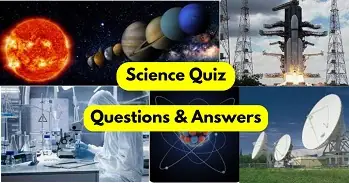100 General Knowledge Questions and Answers - GK Questions with Answers
Explore 100 General Knowledge Questions and Answers - GK Questions with Answers: In this article, we have compiled a diverse set of General Knowledge Questions and Answers, covering important topics like Geography, History, Science, Sports, World, Public Administration, Space, Art and Culture, Environment, Awards and many more.
General Knowledge Questions and Answers plays a very important role in general awareness section of various competitive exams like UPSC, SSC, Banking, Defence, etc. It gives a broad understanding about various subjects like Current Affairs, History, Geography, Science, Space, Public Administration, Art and Culture, etc. Questions and Answers format for General Knowledge helps in active retention of important GK facts and information. It also enhances communication skills, creativity, and problem-solving abilities.
100 General Knowledge Questions and Answers - GK Questions with Answers

Geography - GK Questions with Answers
1.Which river flows close to the Siliguri Corridor? A.Teesta River B.Ganga River C.Brahmaputra River D.Subansiri River Answer: A) Teesta River. Explanation: The river flows close to the Siliguri Corridor....
History - GK Questions with Answers
1.Which is the oldest empire in India? A.Mauryan Empire B.Gupta Empire C.Mughal Empire D.Magadha Empire Answer: A) Mauryan Empire. Explanation: The Mauryan Empire (322 BCE – 185 BCE) is considered the first and oldest major empire in India.....
Environment - GK Questions with Answers
1.Which is India's first marine biosphere reserve? A.Sundarbans Biosphere Reserve B.Gulf of Mannar Biosphere Reserve C.Nanda Devi Biosphere Reserve D.Nicobar Biosphere Reserve Answer: B) Gulf of Mannar Biosphere Reserve......
Science - GK Questions with Answers
1.What is the largest organ in the human body? A)Liver B)Heart C)Skin D)Lungs Answer: C) Skin. Explanation: The skin is the largest organ of the human body, covering an average area of 1.5 to 2 square meters in adults.....
World Geography - GK Questions with Answers
1.How many oceans are there in the world? A.3 B.5 C.7 D.4 Answer: B) 5. Explanation: There are five oceans on Earth — the Pacific Ocean, Atlantic Ocean, Indian Ocean, Southern (Antarctic) Ocean, and Arctic Ocean.....
Sports - GK Questions with Answers
1.Who holds the current World No.1 in men's singles tennis as of mid–2025? A)Carlos Alcaraz B)Novak Djokovic C)Jannik Sinner D)Alexander Zverev Answer: C) Jannik Sinner. Explanation: As of mid-2025, Jannik Sinner from Italy is ranked....
Polity and Constitution - GK Questions with Answers
1.Who appoints the Chief Election Commissioner of India? A.President of India B.Prime Minister of India C.Chief Justice of India D.Lok Sabha Speaker Answer: A) President of India. Explanation: The Chief Election Commissioner (CEC) is appointed by....
Space - GK Questions with Answers
1.Which is the hottest planet in the solar system? A.Mercury B.Mars C.Jupiter D.Venus Answer: D) Venus. Explanation: Venus is the hottest planet in our solar system, with surface temperatures reaching about 465°C....
Art and Culture - GK Questions with Answers
1.Bharatanatyam is a classical dance form of which Indian state? A.Kerala B.Karnataka C.Tamil Nadu D.Andhra Pradesh Answer: C) Tamil Nadu. Explanation: Bharatanatyam is one of the oldest classical dance forms of India, originating from the temples of Tamil Nadu....
Awards - GK Questions with Answers
1.Who was the first Indian to win a Pulitzer Prize? A.R. K. Narayan B.Arundhati Roy C.Jhumpa Lahiri D.Gobind Behari Lal Answer: D) Gobind Behari Lal. Explanation: Gobind Behari Lal was the first Indian to win the Pulitzer Prize in 1937....